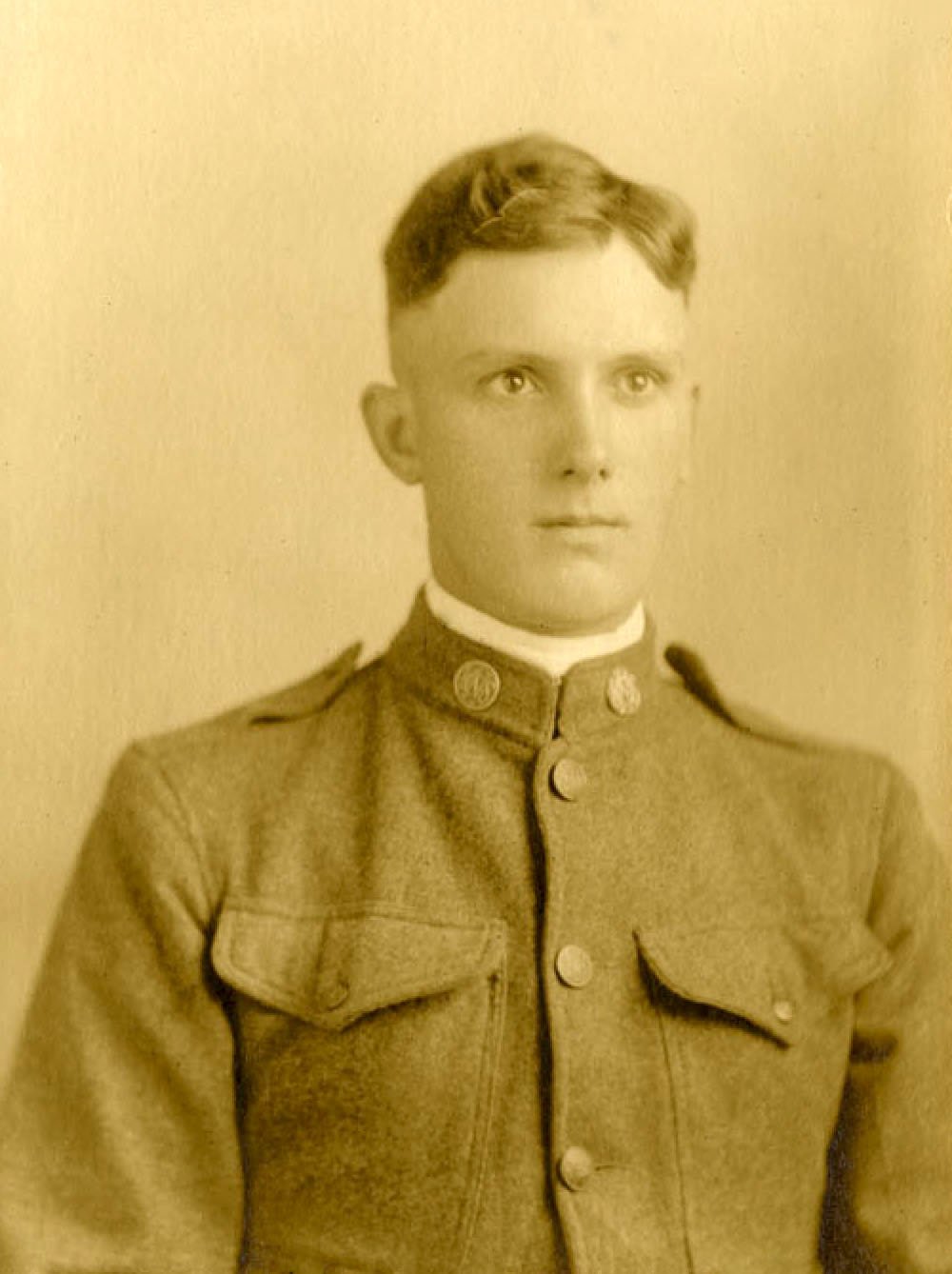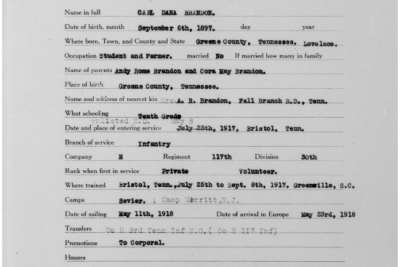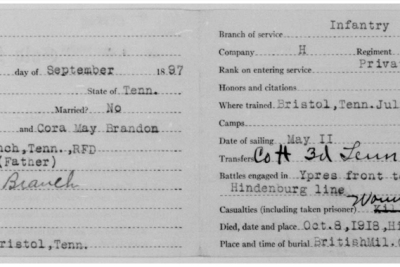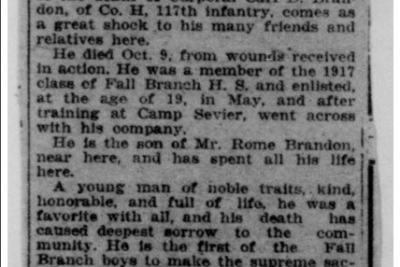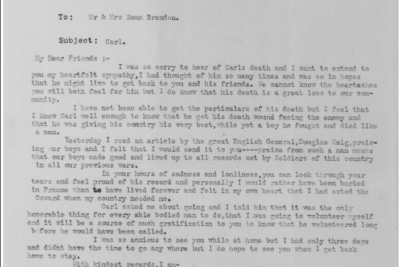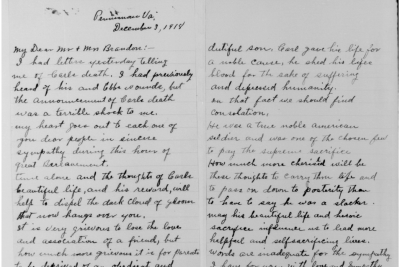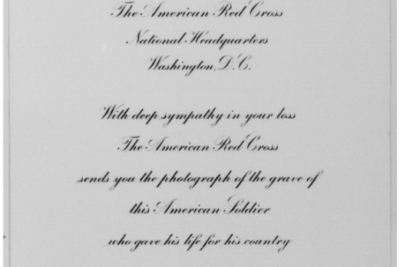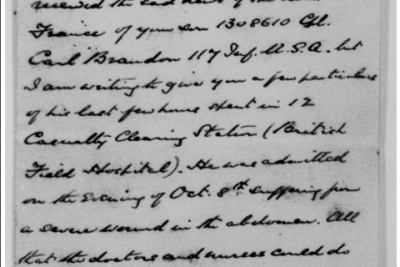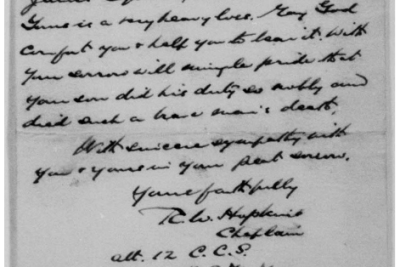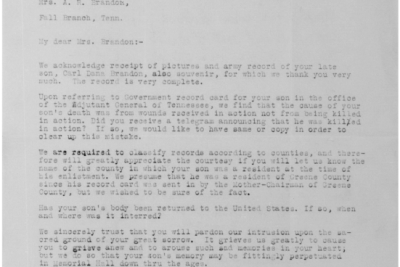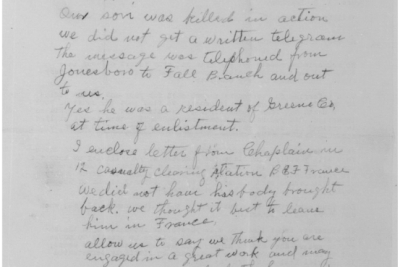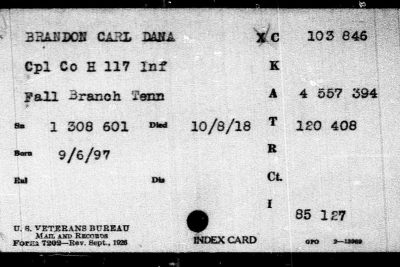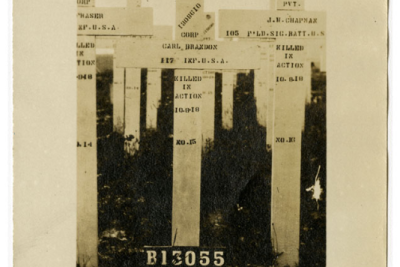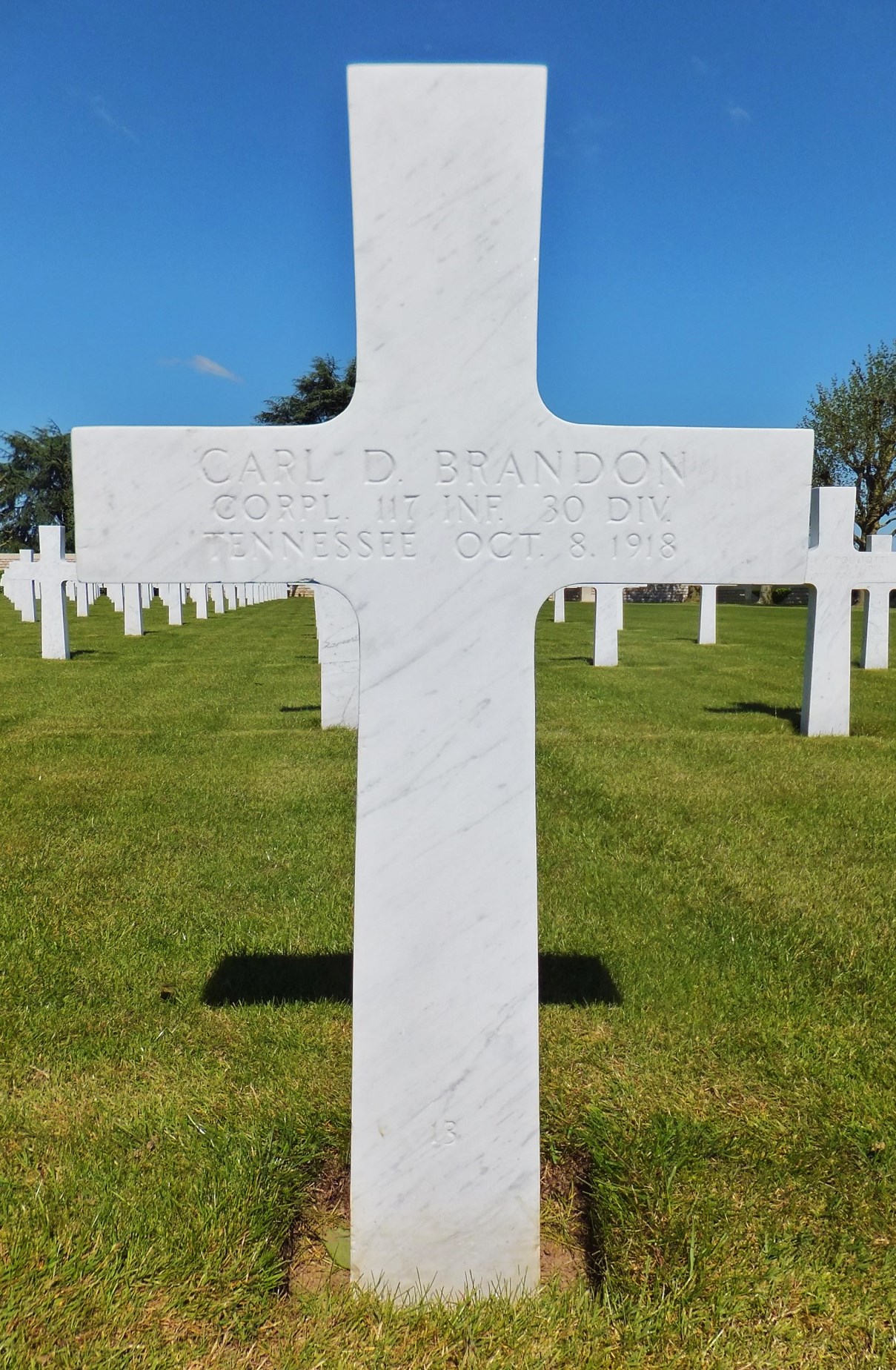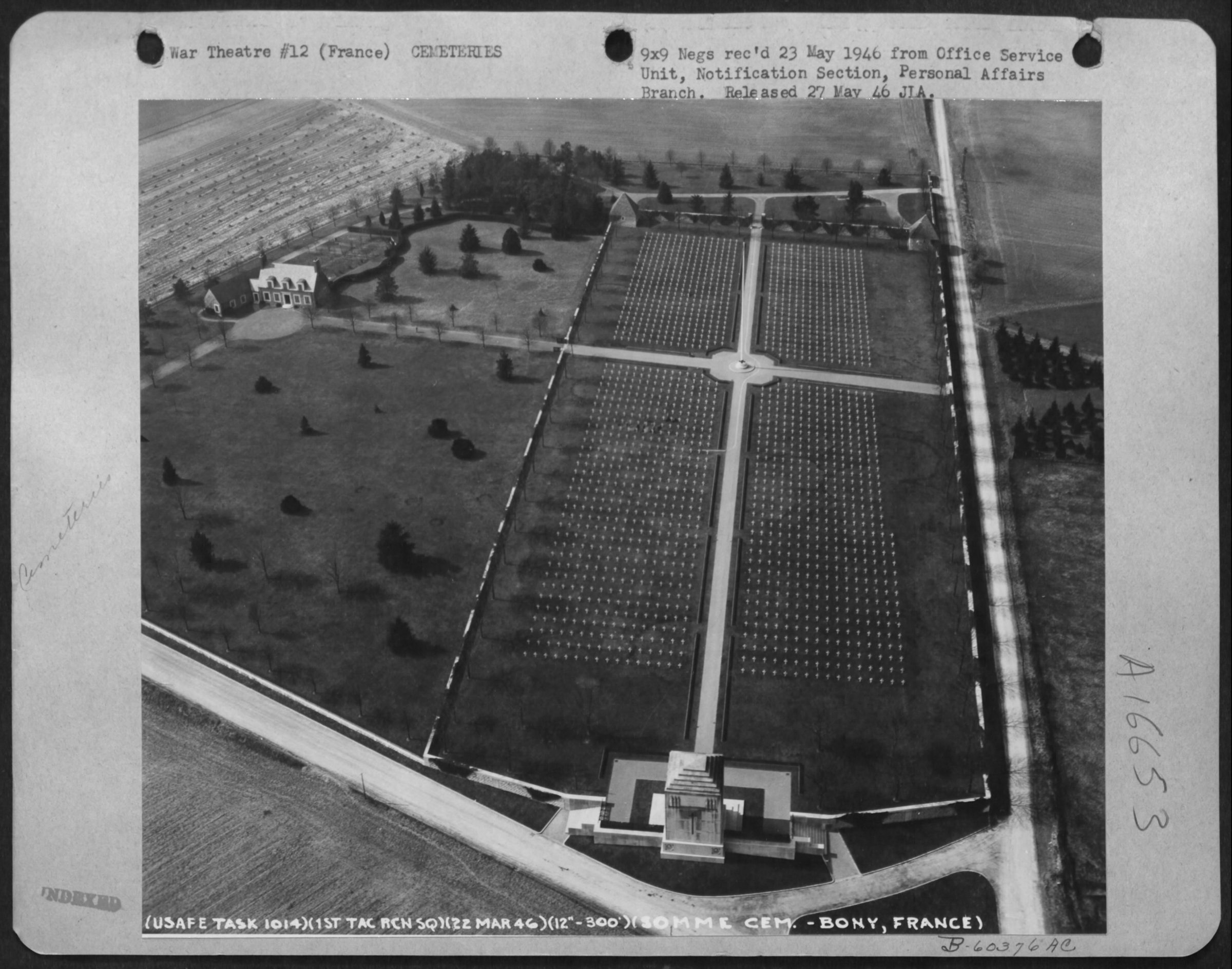Corporal Carl Dana Brandon, Service Number 1308601
Carl was born on 6 September 1897 in Lovelace, Greene County, Tennessee. He was living in Fall Branch, Washington County, Tennessee with his family when he enlisted in the National Guard in Bristol, Sullivan County, Tennessee on 8 May 1917 at the age of 19 with two of his uncles. Carl had just graduated from the Fall Branch High School with the Class of 1917 and was their class’s Salutatorian. He was assigned to Company H, 3rd Infantry Regiment, Tennessee Army National Guard stationed at Bristol with the rank of Private.
The 3rd Infantry after being called to active service in the United States Army on 25 July 1917 would soon become part of the 117th Infantry Regiment, 59th Infantry Brigade, 30th Division. Carl stayed with Company H, 2nd Battalion and was promoted to Private First Class on 1 September. After that his unit was dispatched to and arrived Camp Sevier, Greenville, South Carolina for training on 8 September. There they would join units from North and South Carolina, as well as those from Tennessee to form the core of the 30th Division, later known as the Old Hickory Division in honor of General and President Andrew Jackson. Carl’s skills as a soldier improved and due to his potential as a leader, he was promoted to Corporal on 18 September 1917 and now a non-commissioned officer.
Carl departed Camp Sevier on 5 May 1918 with Company H for Camp Mills, Long Island, New York to await transportation overseas. He along with others were given leave and for days afterwards and on the ship nursed sore necks from the hours they spent looking at all the tall skyscrapers of New York City. After boarding the SS Northumberland in Brooklyn, New York, they set off for Liverpool, England on 11 May and arrived on 23 May. After disembarking the ship he and the four infantry regiments of the 30th Division boarded troop trains and were taken to the port cities of Dover and Folkestone for the channel crossing over the next couple of days. He and his company arrived the port city of Calais, France on the 25th. As the 30th Division piecemealed into France just as they had done into England, they were taken to Audruicq by train and marched the short distance to the various towns and villages known as the Eperlecques Training Area in France. Carl was billeted with the 117th at Nortbecourt and began Phase “A” Training with the British 39th Division on 10 June 1918.
Phase “A” was to be completed on 10 July, but was extended to the morning of 16 July. Phase “B” began the same day for the 30th Division with a three day march into Belgium. Upon arriving the Poperinghe Area, the 117th was billeted in one of the numerous camps and were intergraded over the next month into actual battlefield operations and trench warfare conditions with active combat units. Phase “B” was completed on 10 August and Phase “C” the last training phase was cancelled and the 30th were declared combat ready. Operational orders came in on the 14th and the 30th Division was to relieve the British 33rd Division starting the night of 16 August in the Canal Sector near Ypres, Belgium. The Ypres-Lys Offensive began on 19 August 1918 and the 30th would be in the thick of the fighting to the very end of the war.
Carl and the 30th were given a breathing spell after being relieved from the Ypres-Lys Offensive on 5 September and were entrained to the St. Pol area and companies F, G & H of the 117th were billeted at Beauvois, France to resupply, do some more training and get a little rest from all the heavy artillery explosions. On the 17th the 30th Division made the move to the Puchevillers Area where they would come under the control of the 4th British Army on the 21st as would the American 27th Division to join in the Somme Offensive, also known as the One Hundred Day Offensive.
It was during this offensive on 8 October 1918, the first assault day of the Battle of Montbrehain that Carl was severely hit in the abdomen. In the early evening of the 8th, he was admitted to Number 12 Casualty Clearing Station of the British Expeditionary Force’s Army Field Hospital in Busigny, France where he died from those wounds at 2300 hours (11pm) that same evening.
Carl participated in two Unit Campaigns: Ypres-Lys Offensive in Belgium and the Somme Offensive in France. He also fought in the Battle of Bellicourt on the Hindenburg Line. Carl was 21 years old and was first interred at the British Military Cemetery at Fricourt, France and later moved to the Somme American Cemetery, Plot D, Row 4, Grave 13 in Bony, France after his parents decided what Carl would have, to stay with his brothers in arms, his mates.
Carl’s the son of Andrew Jerome Brandon and Cora May Pierce. Cora’s younger brother Elbert Rueben Pierce who was also wounded during the war and was with Carl when he was hit brought home a piece of a German machine gun that Carl had captured and gave it to her. Cora at age 52 sailed to France aboard the SS President Roosevelt in July 1930 to visit Carl’s grave during a Gold Star Mothers Pilgrimage.
— Submitted by Allen D. Jackson, USAF (Ret) Historian, Johnson City/Washington County TN Veterans Memorial Foundation
- Rank: Corporal
- Date of birth: 6 September 1897
- Date of death: 8 October 1918
- County: Greene
- Hometown: Fall Branch
- Service Branch: Army
- Division/Assignment: Company H, 117th Infantry Regiment, 30th Division
- Theater: Europe
- Conflict: World War I
- Battles: Ypres, Bellicourt, Somme, Hindenburg Line, Montbrehain
- Burial/Memorial Location: Somme American Cemetery, Bony, France
- Location In Memorial: Pillar III, Top Panel
- Contact us to sponsor Carl D. Brandon
Image Gallery
Click a thumbnail below to view at full size.

